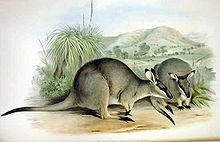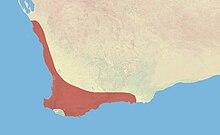Western brush wallaby
| Western brush wallaby | |
|---|---|
 |
|
| Scientific classification | |
| Kingdom: | Animalia |
| Phylum: | Chordata |
| Class: | Mammalia |
| Infraclass: | Marsupialia |
| Order: | Diprotodontia |
| Family: | Macropodidae |
| Genus: | Macropus |
| Species: | M. irma |
| Binomial name | |
|
Macropus irma (Jourdan, 1837) |
|
 |
|
| Western brush wallaby range | |
The western brush wallaby (Macropus irma), also known as the black-gloved wallaby, is a species of wallaby found in the southwest coastal region of Western Australia. The wallaby's main threat is predation by the introduced red fox (Vulpes vulpes). The IUCN lists the western brush wallaby as Least Concern, as it remains fairly widespread and the population is believed to be stable or increasing, as a result of fox control programs.
The western brush wallaby has a grey colour with distinctive white colouring around the face, arms and legs (although it does have black gloves as its alternative common name implies). It is an unusually diurnal macropod that eats mainly grass.
The western brush wallaby was first scientifically described by Claude Jourdan in 1837. Synonyms include Halmaturus irma and M. manicatus contributed by Jay Gould in 1852. It also goes by the common names of the Kwoora or the black-gloved wallaby. The western brush wallaby falls under the order Diprotodontia which is composed of marsupials with only one pair of incisors in the lower jaw (although a second, non-functional pair may be present), three pairs of uppers incisors, and no lower canine teeth. All of these characteristics of the teeth are clear adaptions for an herbivorous diet. The western brush wallaby is in the superfamily Macropodoidea, the suborder Phalangerida, and the subgenus Notamacropus. They are part of the largest family of marsupials, Macropodidae, which are believed to have become secondarily terrestrial after descending from arboreal marsupials.
Little is known about the behaviour of the western brush wallaby, however much of their behavior is consistent with that of other members of the family Macropodidae.
Although quite small, the western brush wallaby's coloring resembles the larger kangaroos of the region. The western brush wallaby's head and body length usually falls around 1.2 m. Their tail length, which ranges from 54–97 cm, is proportionally long to their smaller body size. The adult western brush wallaby weighs anywhere from 7.0-9.0 kg. Their coloring consists of a pale to mid gray coat with a distinct white facial stripe. Other distinct features include black and white ears, black hands and feet, and crest of black hairs on the tail. The size of the male and female are quite similar.
...
Wikipedia

